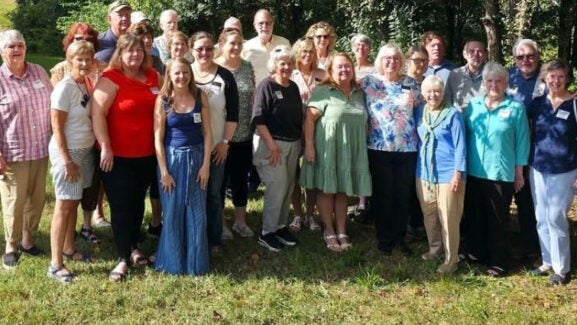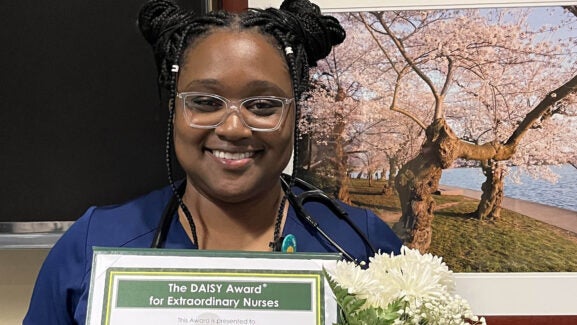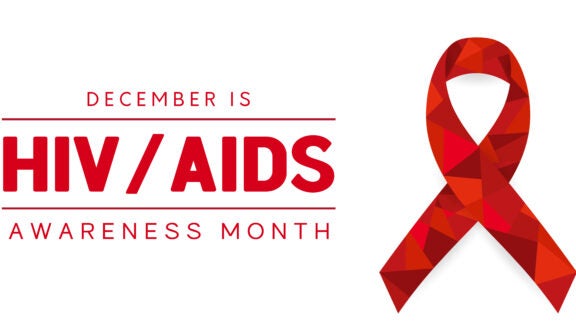

Jennifer “JT” Hall, RN, Magnet Program Coordinator
The Pull of Magnet: Speed Dating for Stories and Creating Standards Make UVA Health Stronger
UVA is part of a top-tier of hospitals – just 10% – with a Magnet designation. Research shows that Magnet facilities attract and retain the best nurses, have the best patient care and outcomes, and have higher financial stability.
The Magnet Recognition Program was developed by the American Nurses Credentialing Center (ANCC) in 1994 with an evidence-based approach that makes it one of the most stringent and respected care models. Magnet recognizes health care organizations for meeting nursing benchmarks in four areas:
- Quality patient care
- Interdisciplinary collaboration
- High standards for nursing practice
- Innovations through quality improvement and nursing research
“You cannot have a great hospital without great nursing,” says Jennifer “JT” Hall, RN, Magnet Program Coordinator. Hall also notes that “Magnet is nursing-centric, but it is an organizational recognition and designation.” She calls it a “team sport,” and we all get to play.
Pursuing Magnet
UVA achieved Magnet designations in 2006 and 2015 and now, four years later, it’s time to reapply. We are currently in the process of redesignation.
There are two main components of the Magnet application process: documentation and site visit. Hall and the Magnet core team submitted the required documentation in May, and if the documentation is deemed acceptable, we would be eligible for a site visit, which may take place in early 2020.
The completed Magnet document is 512 pages long, includes 2,038 pages of supporting evidence, and cites 519 names. And yes, compiling it is a big undertaking. Hall began writing the document about a year before submitting it. Extensive storytelling and documentation are required to fulfill all the requirements.
Hall pondered in the early stages of the process: “How do you harvest all those leads, especially in a large organization?” In response, she created a speed-dating concept to gather examples and tell the Magnet story.
About 90 leaders and 45 clinical nurses gathered at these speed-dating events and hovered around stations in four-minute intervals. Each station had a worksheet with a Magnet standard, and the participants wrote down relevant examples from their practice. The worksheet asked for detailed info, like when and where the example happened, the names of the nurses, if it is a new or revised idea, and what supporting evidence exists (meeting minutes, screenshots, etc.).
The speed dating concept was a huge success. The exercise generated 450 leads, which Hall organized and mined for viable examples of how the organization lives up to the Magnet standards every day. She estimates that 70% of content from the final Magnet document came from the speed-dating ideas.
Due to the success of the idea, Hall will present the concept at the ANCC National Magnet Conference this fall.
4 appraisers, 4 days
The expected site visit will take place over the course of four days with four appraisers. They will meet with team members in patient-care areas, Professional Nursing Staffing Organization committees, nursing and executive leadership, and community members.
Hall coaches nurses to talk to the appraisers in preparation for the expected site visit. “It’s hard to get a nurse to brag about themselves,” she says. “But, it’s not hard to get nurses to talk about their nursing practice and their commitment to their patients.”
It’s been a journey
In 2009, the Magnet standards changed from a storytelling, narrative model to a storytelling and data model with a special focus on nursing-sensitive indicators, like pressure injuries, patient falls, infection rates, and engagement data. In 2011, a decision was made to voluntary withdraw from Magnet redesignation.
“We weren’t meeting the expected outcomes,” Hall says. “It was a real pivot point for our organization.”
Many large-scale changes occurred during this time: New executive leadership was established, Epic launched for the first time, and focus turned to the Magnet requirements.
“Be Safe arrived in 2014, so as we were going into our 2015 redesignation, I think that initiative really accelerated our ability,” Hall says.
In 2015, we were ready, and UVA was once again declared a Magnet hospital.
“This wasn’t about getting Magnet, this was about being Magnet,” Hall says. “And I feel like we’ve stayed committed to that.”
Reaping the rewards
Shortly after our 2019 Magnet document was submitted for review, Hall took a well-deserved break to unwind from the year-and-a-half whirlwind. Her passion for the work is evident in her enthusiasm and proven results.
“I love that I get to know people in every area,” she says. “I get to learn about these stories and just swim around in these totally inspiring stories. … I don’t know that there’s any other snapshot in time that we create like a Magnet document. It’s such a unique archive.”
The Magnet core team continues to work with ANCC on our redesignation. The team recently received a request for clarifying information for the document. If the response is deemed acceptable, the next step would be a site visit. Final designation results are expected six to eight weeks after the site visit.
Thank you to JT, the Magnet team, and everyone who contributed to Magnet redesignation. We appreciate your hard work!
Latest News



